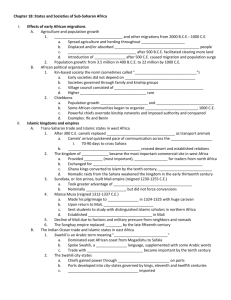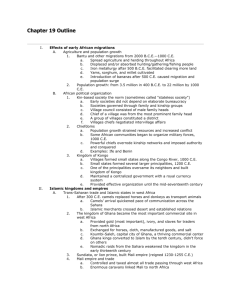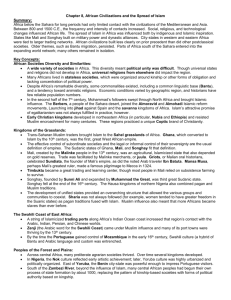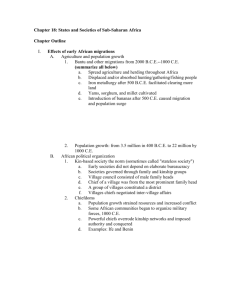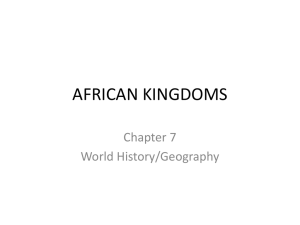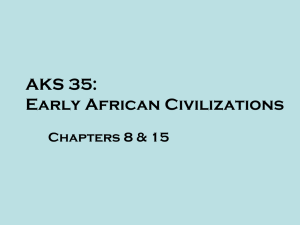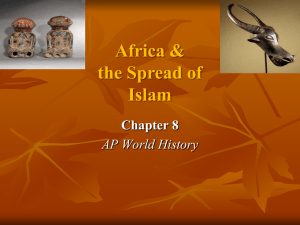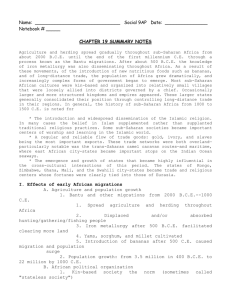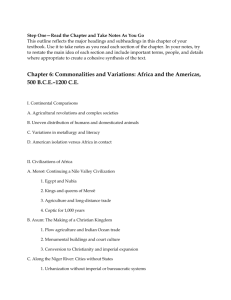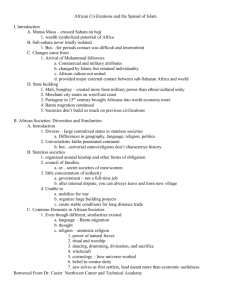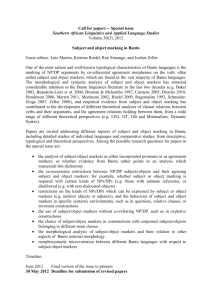The Bantu Migrations Lecture Notes
advertisement
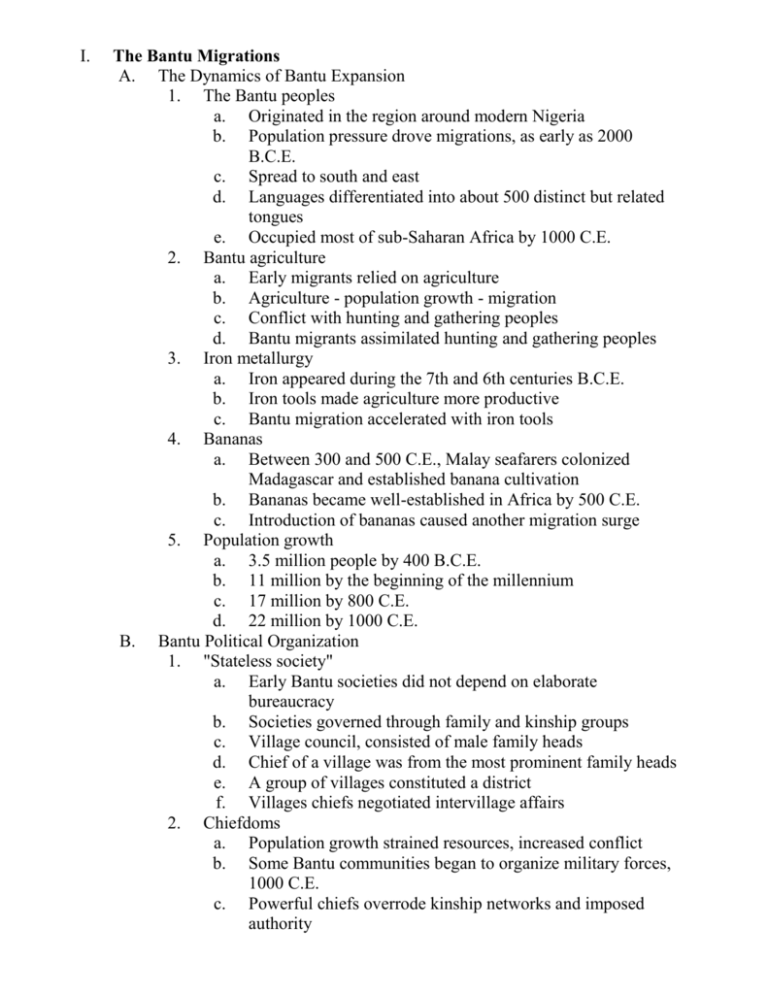
I. The Bantu Migrations A. The Dynamics of Bantu Expansion 1. The Bantu peoples a. Originated in the region around modern Nigeria b. Population pressure drove migrations, as early as 2000 B.C.E. c. Spread to south and east d. Languages differentiated into about 500 distinct but related tongues e. Occupied most of sub-Saharan Africa by 1000 C.E. 2. Bantu agriculture a. Early migrants relied on agriculture b. Agriculture - population growth - migration c. Conflict with hunting and gathering peoples d. Bantu migrants assimilated hunting and gathering peoples 3. Iron metallurgy a. Iron appeared during the 7th and 6th centuries B.C.E. b. Iron tools made agriculture more productive c. Bantu migration accelerated with iron tools 4. Bananas a. Between 300 and 500 C.E., Malay seafarers colonized Madagascar and established banana cultivation b. Bananas became well-established in Africa by 500 C.E. c. Introduction of bananas caused another migration surge 5. Population growth a. 3.5 million people by 400 B.C.E. b. 11 million by the beginning of the millennium c. 17 million by 800 C.E. d. 22 million by 1000 C.E. B. Bantu Political Organization 1. "Stateless society" a. Early Bantu societies did not depend on elaborate bureaucracy b. Societies governed through family and kinship groups c. Village council, consisted of male family heads d. Chief of a village was from the most prominent family heads e. A group of villages constituted a district f. Villages chiefs negotiated intervillage affairs 2. Chiefdoms a. Population growth strained resources, increased conflict b. Some Bantu communities began to organize military forces, 1000 C.E. c. Powerful chiefs overrode kinship networks and imposed authority II. d. Some chiefs conquered their neighbors 3. Kingdom of Kongo a. Villages formed small states along the Congo River, 1000 C.E. b. Small states formed several larger principalities, 1200 C.E. c. One of the principalities overcame its neighbors and built kingdom of Kongo d. Maintained a centralized government with a royal currency system e. Provided effective organization until the mid-17th century Islamic Kingdoms and Empires A. Trans-Saharan Trade and Islamic States in West Africa 1. Camels a. Camels came to north Africa from Arabia, 7th century B.C.E. b. After 500 C.E. camels replaced horses and donkeys as transport animals c. Camels' arrival quickened pace of communication across the Sahara d. Islamic merchants crossed the desert and established relations with sub-Saharan west Africa, by the late 8th century 2. The kingdom of Ghana a. A principal state of west Africa, not related to modern state of Ghana b. Became the most important commercial site in west Africa c. Provided gold, ivory, and slaves for traders from north Africa d. Exchange for horses, cloth, manufactured goods, and salt 3. Koumbi-Saleh a. The capital city of Ghana, a thriving commercial center b. Ghana kings maintained a large army of two hundred thousand warriors 4. Islam in west Africa a. Ghana kings converted to Islam by the 10th century b. Allowed the people to observe their traditional beliefs c. Nomadic raids from the Sahara weakened the kingdom, the early 13th century 5. Sundiata a. After Ghana dissolved, political leadership shifted to Mali empire b. The lion prince Sundiata (reigned 1230-55) built the Mali empire 6. The Mali empire and trade a. B. Controlled and taxed almost all trade passing through west Africa b. Enormous caravans linked Mali to north Africa c. Besides the capital Niani, many other prosperous cities on caravan routes 7. Mansa Musa a. Sundiata's grand nephew, reigned from 1312 to 1337 b. Made his pilgrimage to Mecca in 1324-1325 1. a gargantuan caravan of thousand soldiers and attendants 2. gold devalued 25% in Cairo during his visit 8. Mansa Musa and Islam a. Upon return to Mali, built mosques b. Sent students to study with distinguished Islamic scholars in northern Africa c. Established Islamic schools in Mali 9. The decline of Mali a. Factions crippled the central government b. Military pressures from neighboring kingdoms and desert nomads c. The Songhay empire replaced Mali by the late 15th century The Indian Ocean Trade and Islamic States in East Africa 1. Early visitors to east Africa a. Indian and Persian sailors visited the coasts after about 500 B.C.E. b. Hellenistic and Roman mariners reached the same coasts c. Malay seafarers established colonies on Madagascar d. By the 2nd century, Bantu peoples populated much of east Africa 2. The Swahili a. An Arabic term, meaning "coasters" b. Dominated east African coast from Mogadishu to Sofala c. Spoke Swahili, a Bantu language supplemented with some Arabic words d. Trade with Muslim merchants became important by the 10th century 3. The Swahili city-states a. Chiefs gained power through taxing trade on ports b. Ports developed into city-states governed by kings, 11th and 12th centuries 4. Kilwa a. One of the busiest city-states on east coast b. Multistory stone buildings and copper coins, from the 13th century c. III. By the late 15th century, Kilwa exported about a ton of gold per year 5. Zimbabwe a. A powerful kingdom of east Africa b. The 5th and 6th centuries C.E., wooden residences known as zimbabwe c. By the 9th century, chiefs began to build stone zimbabwe d. The magnificent stone complex known as Great Zimbabwe, the 12th century e. Eighteen thousand people lived in Great Zimbabwe in the late 15th century f. Kings organized flow of gold, ivory, and slaves 6. Islam in East Africa a. Ruling elite and wealthy merchants converted to Islamic faith b. Conversion promoted close cooperation with Muslim merchants c. Conversion also opened door to political alliances with Muslim rulers Bantu Society and Cultural Development A. Social Classes 1. Diversity of African societies a. Complex societies developed into kingdoms, empires, and city-states b. Coexisted with small states and stateless societies 2. Kinship groups of stateless societies a. Extended families and clans as social and economic organizations b. Communities claimed rights to land, no private property c. Village council allocated land to clan members 3. Sex and gender relations a. Men undertook heavy labor b. Women were responsible for child rearing, domestic chores c. Men monopolized public authority, but women enjoyed high honor as the source of life d. Aristocratic women could influence public affairs e. Women merchants commonly traded at markets f. Sometimes women organized all-female military units g. Islam did little to curtail women's opportunities in subSaharan Africa 4. Age grades a. Publicly recognized "age grades" or "age sets" b. Assumed responsibilities and tasks appropriate to their age grades 5. B. Slavery a. Most slaves were captives of war, debtors, criminals b. Worked as agricultural labor or sold in slave markets 6. Slave trading a. Slave trade increased after the 11th century b. Demand for slaves outstripped supply from eastern Europe c. Slave raids of large states against small states or stateless societies d. In some years, 10 to 12 thousand slaves shipped out of Africa e. Ten million slaves were transported by Islamic trade between 750 and 1500 African Religion 1. Creator god a. Recognized by almost all African peoples b. Created the earth and humankind, source of world order 2. Lesser gods and spirits a. Often associated with natural features b. Participated actively in the workings of the world c. Believed in ancestors' souls 3. Diviners a. Mediated between humanity and supernatural beings b. Interpreted the cause of the people's misfortune c. Used medicine or rituals to eliminate problems d. African religion was not theological, but practical 4. The Arrival of Christianity and Islam 5. Early Christianity in north Africa a. Christianity reached north Africa during the first century C.E. b. It had no influence on sub-Saharan African 6. The Christian kingdom of Axum a. The first Christian kingdom, 4th century C.E., located in modern Ethiopia b. In later centuries, it was surrounded by Islamic neighbors 7. Ethiopian Christianity a. Had little contact with Christians of other lands b. Shared basic Christian theology and rituals, but developed its own features 8. African Islam a. Appealed strongly to ruling elite and merchants of subSaharan Africa b. Became part of inherited traditions c. Accommodated African gender relations d. Supplemented rather than replaced traditional religions
